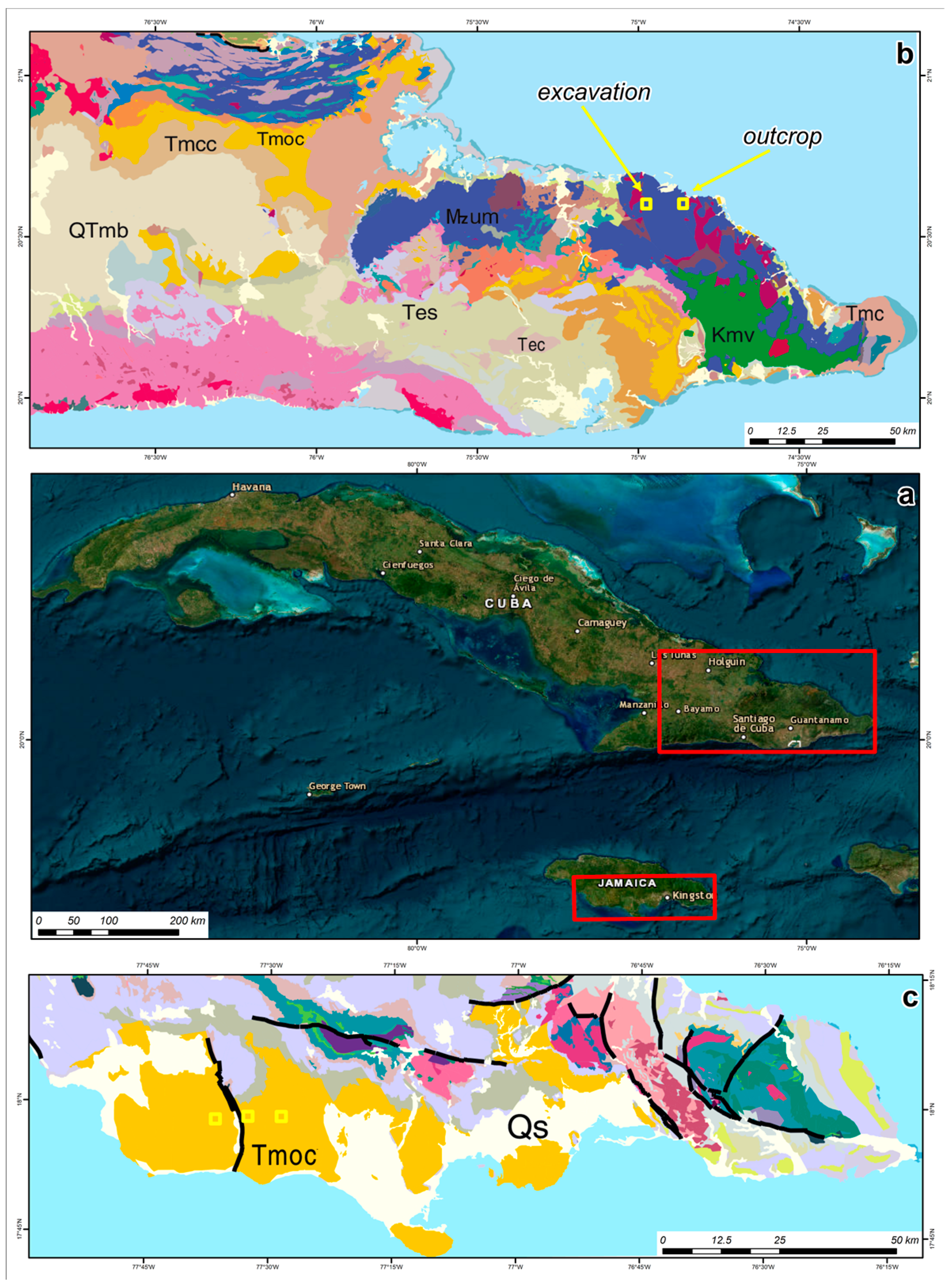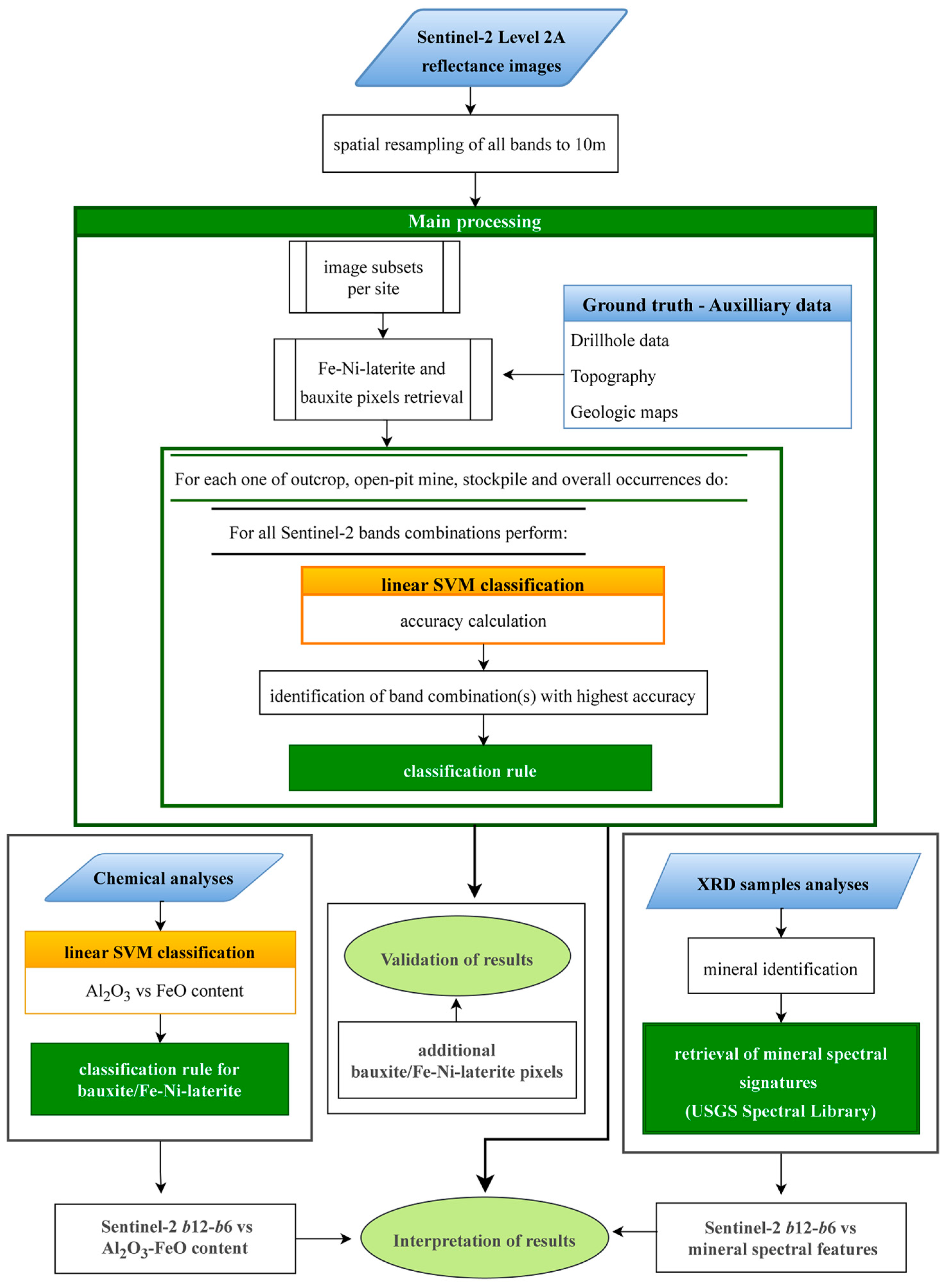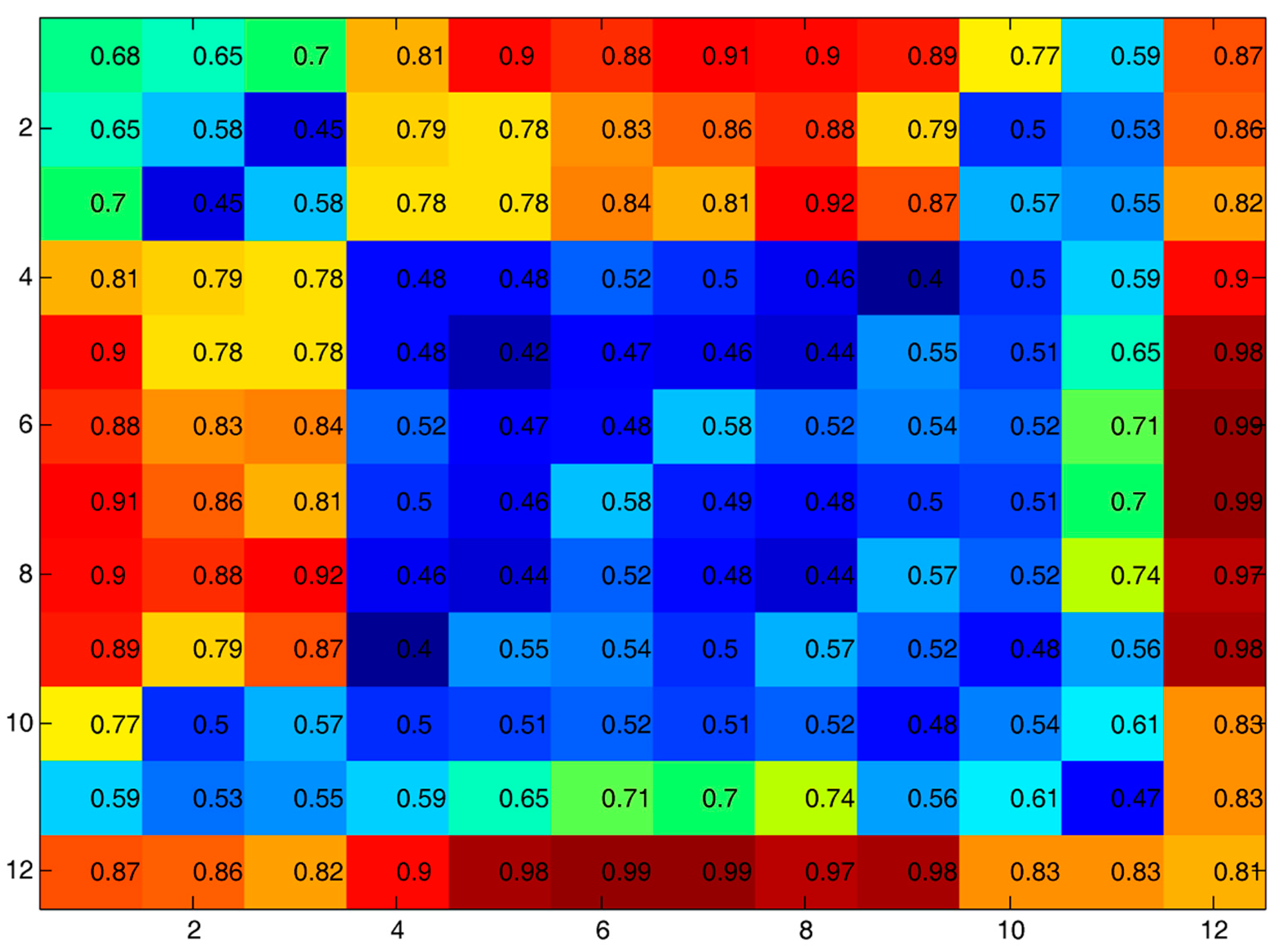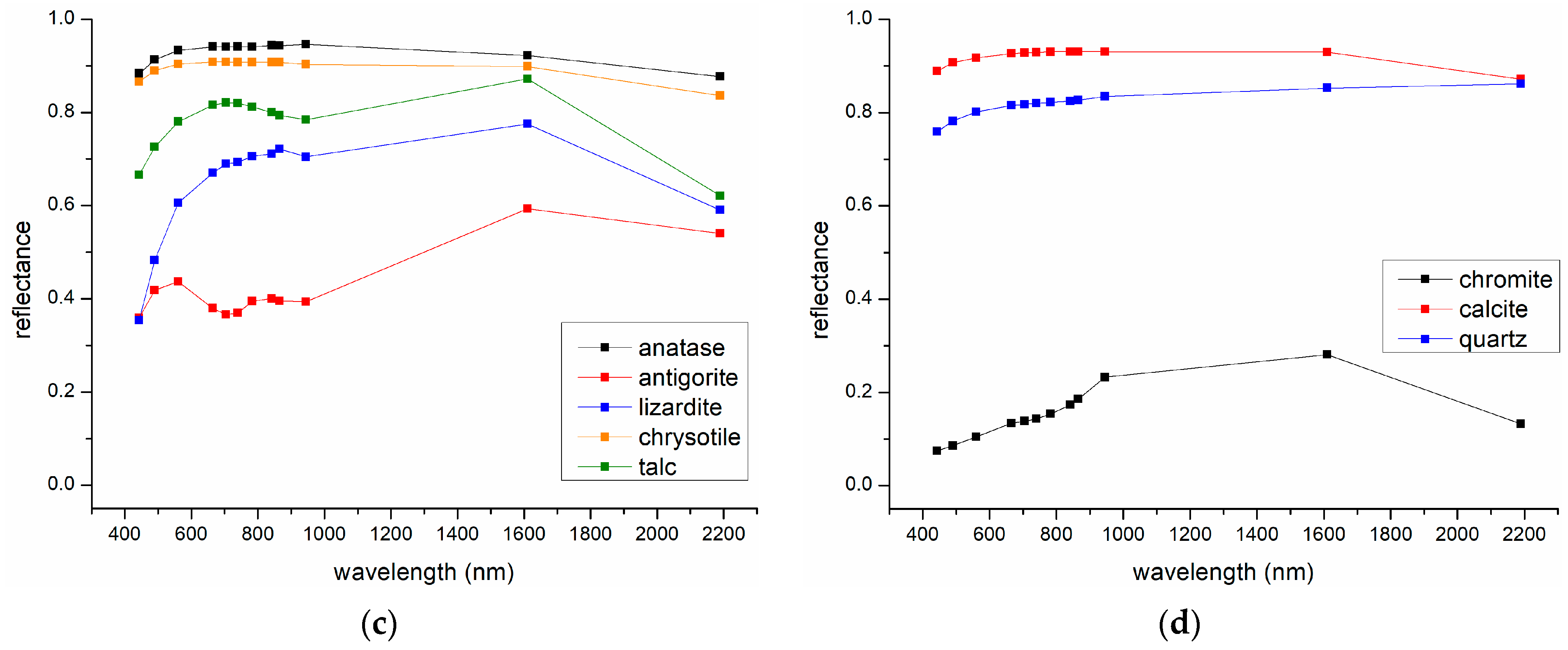Discrimination of Fe-Ni-Laterites from Bauxites Using a Novel Support Vector Machines-Based Methodology on Sentinel-2 Data
Abstract
:1. Introduction
2. Materials and Methods
2.1. Site Description
2.1.1. Ore geology and Ore Beneficiation Plants
- 1.
- Fe-Ni-laterites
- 2.
- Bauxites
2.1.2. Ore Mineralogy and Chemistry
- 1.
- Fe-Ni-laterites
- 2.
- Bauxites
2.2. Materials
2.2.1. Spaceborne Data
2.2.2. Laboratory Analyses
- In the Kopaida open-pit mine, the minerals that are present are goethite, quartz, calcite, montmorillonite, antigorite, or lizardite (Figure S3a);
- A Ni-rich bauxite ore sample was obtained from the contact between the lowermost part of the bauxite laterite ore and the carbonate basement from the Patitira open-pit mine. The minerals identified are boehmite, diaspore, hematite, anatase, kaolinite, goethite, quartz, allophane, and calcite (Figure S3b);
- The Tsouka open-pit mine samples are composed mostly of quartz, hematite, antigorite, calcite, clinochrysotile, actinolite, talc, goethite, montmorillonite, lizardite, and orthochrysotile (Figure S3c).
2.2.3. Auxiliary Data
- Drillhole data of Tsouka, Nisi, and Kopaida Fe-Ni-laterite, including lithological descriptions, were collected from LARCO GMMSA. The drillhole data combined with the topographic data were used for the selection of Fe-Ni-laterite pixels in the Sentinel-2 images;
- Topographic data within the Tsouka, Nisi, and Kopaida Fe-Ni-laterite open-pit mines, measured at the acquisition dates of the Sentinel-2 images (Table S1), were also collected by LARCO GMMSA;
- The geologic maps that cover both Fe-Ni-laterite and bauxite outcrop areas. For the Greek sites, the geologic maps that were used are published by the Greek Institute of Geology and Mineral Exploration (EAGME, former IGME) at a 1:50,000 scale. For the Cuba sites, a digitized geologic map was used, presented in [72], issued from the geological map of Cuba compiled from the Geological Map of Cuba 1:500,000 [73]. The geologic maps were used for the Fe-Ni-laterite/bauxite pixel selections when no other external data were available (e.g., drillholes);
- Google Earth was used as complementary information for the location of Fe-Ni-laterite and bauxite stockpiles at the Triveio laterite grinding factory and the bauxite transport zones of Itea, Stylida, and the three Jamaica sites.
2.3. Methodology
2.3.1. Satellite Data Pre-Processing
2.3.2. Main Processing
3. Results
3.1. Fe-Ni-Laterite and Bauxite Pixel Spectral Signatures
3.1.1. Outcrops
3.1.2. Open-Pit Mines
3.1.3. Stockpiles
3.2. Classification Results
3.2.1. Band Combination Selection
3.2.2. Classification Rules
3.2.3. Performance Evaluation
4. Discussion
4.1. Spectral Features and Fe-Ni-Laterite/Bauxite Mineralogy
- The 700–800 nm reflectance feature: among the spectral signatures of all minerals detected by the XRD sample analyses (Figure 9), this reflectance feature is a common ferric feature [78] and it is observed only in goethite and hematite spectra (Figure 9a). In particular, a high reflectance feature centered in for hematite and in for goethite was observed. Therefore, these reflectance features can be related to the presence of hematite and goethite correspondingly, which are common in both ores and which can be clearly seen in Figure S4a,b.
- The 1600–2200 nm spectral area: among the spectral signatures of the minerals detected by the XRD analyses of the exploitation’s samples (Figure 9), a negative slope between and () is observed in the spectral signatures of several minerals (Figure 9b–d). These minerals are (i) OH-bearing minerals with various chemical compositions, namely Al-OH bearing minerals such as diaspore, kaolinite, and montmorillonite; Mg-OH bearing minerals (talc); chlorites (clinochlore); and serpentines such as antigorite, chrysotile, and lizardite; (ii) chromite; (iii) anatase; (iv) quartz; and (v) calcite. This feature is related to various absorption features within the 2000–2200 nm spectral area of the original spectra of the aforementioned non-ferric minerals, the wavelength position of which depends on each specific mineral chemical composition [78] (e.g., Figures S5c–f and S4). With the exception of calcite and quartz (and hematite and goethite), this type of mineralogy differs between Fe-Ni-laterites and bauxites (Table S6). In particular, Fe-Ni-laterites are composed of montmorillonite, chromite, talc, clinochlore, antigorite, chrysotile, and lizardite, while bauxites are composed of diaspore, gibbsite, kaolinite, anatase, and allophane. Therefore, seems to be generally related to the Fe-Ni-laterite/bauxite non-ferric mineral phases (Figure S4c–f). The full spectra of all minerals detected in the open pits of both ores are presented in Figure S5.
4.2. Classification Rules and Fe-Ni-Laterite/Bauxite Chemistry in Open Pits
4.3. Advantages and Limitations of the Method
5. Conclusions
Supplementary Materials
Author Contributions
Funding
Data Availability Statement
Acknowledgments
Conflicts of Interest
References
- Ayres, R.; Peiró, T.L. Material efficiency: Rare and critical metals. Philos. Trans. R. Soc. A 2013, 371, 20110563. [Google Scholar] [CrossRef] [PubMed]
- The Role of Critical Minerals in Clean Energy Transitions. Available online: https://www.iea.org/reports/the-role-of-critical-minerals-in-clean-energy-transitions (accessed on 15 April 2024).
- Minerals for Climate Action: The Mineral Intensity of the Clean Energy Transition. Available online: https://www.commdev.org/wp-content/uploads/pdf/publications/MineralsforClimateActionTheMineralIntensityoftheCleanEnergyTransition.pdf (accessed on 15 April 2024).
- The Growing Role of Minerals and Metals for a Low Carbon Future. Available online: https://documents1.worldbank.org/curated/en/207371500386458722/pdf/117581-WP-P159838-PUBLIC-ClimateSmartMiningJuly.pdf (accessed on 15 April 2024).
- Study on the Critical Raw Materials for the EU 2023: Final Report. Available online: https://data.europa.eu/doi/10.2873/725585 (accessed on 15 April 2024).
- COM(2023) 160-Proposal for a Regulation of the European Parliament and of the Council Establishing a Framework for Ensuring a Secure and Sustainable Supply of Critical Raw Materials. Available online: https://single-market-economy.ec.europa.eu/publications/european-critical-raw-materials-act_en#details (accessed on 15 April 2024).
- RMIS Roadmap 2021: A Mid-Term Progress Report, Roadmap and Analysis of Knowledge Management Options for the Raw Materials Information System (RMIS). Available online: https://op.europa.eu/en/publication-detail/-/publication/6bfa5652-6ea5-11ec-9136-01aa75ed71a1/language-en (accessed on 15 April 2024). [CrossRef]
- Herrington, R.; Mondillo, N.; Boni, M.; Thorne, R.; Tavlan, M. Bauxite and Nickel-Cobalt Lateritic Deposits of the Tethyan Belt. In Tectonics and Metallogeny of the Tethyan Orogenic Belt, 1st ed.; Richards, J.P., Ed.; Society of Economic Geologists: Littleton, CO, USA, 2016; Volume 19, pp. 349–387. [Google Scholar]
- Pour, A.B.; Rahmani, O.; Parsa, M. Editorial for the Special Issue: “Multispectral Remote Sensing Satellite Data for Mineral and Hydrocarbon Exploration: Big Data Processing and Deep Fusion Learning Techniques”. Minerals 2023, 13, 193. [Google Scholar] [CrossRef]
- Shirazi, A.; Hezarkhani, A.; Pour, A.B.; Shirazy, A.; Hashim, M. Neuro-Fuzzy-AHP (NFAHP) Technique for Copper Exploration Using Advanced Spaceborne Thermal Emission and Reflection Radiometer (ASTER) and Geological Datasets in the Sahlabad Mining Area, East Iran. Remote Sens. 2022, 14, 5562. [Google Scholar] [CrossRef]
- Liu, C.; Liu, X.; Hou, M.; Wu, S.; Wang, L.; Feng, J.; Qiu, C. Machine Learning and EPCA Methods for Extracting Lithology–Alteration Multi-Source Geological Elements: A Case Study in the Mining Evaluation of Porphyry Copper Ores in the Gondwana Metallogenic Belt. Minerals 2023, 13, 858. [Google Scholar] [CrossRef]
- Son, Y.S.; You, B.W.; Bang, E.S.; Cho, S.J.; Kim, K.E.; Baik, H.; Nam, H.T. Mapping Alteration Mineralogy in Eastern Tsogttsetsii, Mongolia, Based on the WorldView-3 and Field Shortwave-Infrared Spectroscopy Analyses. Remote Sens. 2021, 13, 914. [Google Scholar] [CrossRef]
- Savitri, K.P.; Hecker, C.; van der Meer, F.D.; Sidik, R.P. VNIR-SWIR infrared (imaging) spectroscopy for geothermal exploration: Current status and future directions. Geothermics 2021, 96, 102178. [Google Scholar] [CrossRef]
- Bishop, C.; Rivard, B.; De Souza Filho, C.; van der Meer, F. Geological remote sensing. Int. J. Appl. Earth Obs. Geoinf. 2018, 64, 267–274. [Google Scholar] [CrossRef]
- Sekandari, M.; Masoumi, I.; Pour, A.B.; Muslim, A.M.; Rahmani, O.; Hashim, M.; Zoheir, B.; Pradhan, B.; Misra, A.; Aminpour, S.M. Application of Landsat-8, Sentinel-2, ASTER and WorldView-3 Spectral Imagery for Exploration of Carbonate-Hosted Pb-Zn Deposits in the Central Iranian Terrane (CIT). Remote Sens. 2020, 12, 1239. [Google Scholar] [CrossRef]
- Van der Werff, H.M.A.; Van der Meer, F. Sentinel-2 for Mapping Iron Absorption Feature Parameters. Remote Sens. 2015, 7, 12635–12653. [Google Scholar] [CrossRef]
- Sykioti, O.; Ganas, A.; Vasilatos, C.; Kypritidou, Z. Investigating the capability of Sentinel-2 and Worldview-3 VNIR satellite data to detect mineralized zones at an igneous intrusion in the Koutala islet (Lavreotiki, Greece) using laboratory mineralogical analysis, reflectance spectroscopy and spectral indices. Bull. Geol. Soc. Greece 2023, 59, 175–213. [Google Scholar] [CrossRef]
- Tompolidi, A.M.; Sykioti, O.; Koutroumbas, K.; Parcharidis, I. Spectral Unmixing for Mapping a Hydrothermal Field in a Volcanic Environment Applied on ASTER, Landsat-8/OLI, and Sentinel-2 MSI Satellite Multispectral Data: The Nisyros (Greece) Case Study. Remote Sens. 2020, 12, 4180. [Google Scholar] [CrossRef]
- Ge, W.; Cheng, Q.; Jing, L.; Wang, F.; Zhao, M.; Ding, H. Assessment of the Capability of Sentinel-2 Imagery for Iron-Bearing Minerals Mapping: A Case Study in the Cuprite Area, Nevada. Remote Sens. 2020, 12, 3028. [Google Scholar] [CrossRef]
- El Atillah, A.; El Abidine El Morjani, Z.; Souhassou, M. Use of the Sentinel-2A Multispectral Image for Litho-Structural and Alteration Mapping in Al Glo’a Map Sheet (1/50,000) (Bou Azzer–El Graara Inlier, Central Anti-Atlas, Morocco). Artif. Satell. 2019, 54, 73–96. [Google Scholar] [CrossRef]
- Ibrahim, E.; Barnabé, P.; Ramanaidou, E.; Pirard, E. Mapping mineral chemistry of a lateritic outcrop in New Caledonia through generalized regression using Sentinel-2 and field reflectance spectra. Int. J. Appl. Earth Obs. Geoinf. 2018, 73, 653–665. [Google Scholar] [CrossRef]
- Van der Meer, F.D.; Van der Werff, H.M.A.; Van Ruitenbeek, F.J.A. Potential of ESA’s Sentinel-2 for geological applications. Remote Sens. Environ. 2014, 148, 124–133. [Google Scholar] [CrossRef]
- Hajaj, S.; El Harti, A.; Jellouli, A.; Pour, A.B.; Himyari, S.M.; Hamzaoui, A.; Hashim, M. Evaluating the Performance of Machine Learning and Deep Learning Techniques to HyMap Imagery for Lithological Mapping in a Semi-Arid Region: Case Study from Western Anti-Atlas, Morocco. Minerals 2023, 13, 766. [Google Scholar] [CrossRef]
- Abedini, M.; Ziaii, M.; Timkin, T.; Pour, A.B. Machine Learning (ML)-Based Copper Mineralization Prospectivity Mapping (MPM) Using Mining Geochemistry Method and Remote Sensing Satellite Data. Remote Sens. 2023, 15, 3708. [Google Scholar] [CrossRef]
- Kodikara, G.R.L.; McHenry, L.J.; Van der Meer, F.D. Application of deep learning and spectral deconvolution for estimating mineral abundances of zeolite, Mg-sulfate and montmorillonite mixtures and its implications for Mars. Planet. Space Sci. 2022, 223, 105579. [Google Scholar] [CrossRef]
- Bachri, I.; Hakdaoui, M.; Raji, M.; Benbouziane, A.; Si Mhamdi, H.S. Identification of Lithology Using Sentinel-2A Through an Ensemble of Machine Learning Algorithms. Int. J. Appl. Geospat. Res. 2022, 13, 1–17. [Google Scholar] [CrossRef]
- Shirmard, H.; Farahbacksh, E.; Muller, D.R.; Chandra, R. A review of machine learning in processing remote sensing data for mineral exploration. Remote Sens. Environ. 2022, 268, 112750. [Google Scholar] [CrossRef]
- Pal, M.; Rasmussen, T.; Porwal, A. Optimized Lithological Mapping from Multispectral and Hyperspectral Remote Sensing Images Using Fused Multi-Classifiers. Remote Sens. 2020, 12, 77. [Google Scholar] [CrossRef]
- Shebl, A.; Abdellatif, M.; Hissen, M.; Abdelaziz, M.I.; Csámer, Á. Lithological mapping enhancement by integrating Sentinel 2 and gamma-ray data utilizing support vector machine: A case study from Egypt. Int. J. Appl. Earth Obs. Geoinf. 2021, 105, 102619. [Google Scholar] [CrossRef]
- Xu, K.; Wang, X.; Kong, C.; Feng, R.; Liu, G.; Wu, C. Identification of hydrothermal alteration minerals for exploring gold deposits based on SVM and PCA using ASTER data: A case study of Gulong. Remote Sens. 2019, 11, 3003. [Google Scholar] [CrossRef]
- Bruno, R.; Kasmaeeyazdi, S.; Tinti, F.; Mandanici, E.; Balomenos, E. Spatial Component Analysis to Improve Mineral Estimation Using Sentinel-2 Band Ratio: Application to a Greek Bauxite Residue. Minerals 2021, 11, 549. [Google Scholar] [CrossRef]
- Sarkar, D.; Sur, P. Targeting the bauxite rich pockets from lateritic terrain utilizing ASTER data: A case study from Kabirdham District, Chhattisgarh, India. J. Earth Syst. Sci. 2021, 130, 189. [Google Scholar] [CrossRef]
- Guha, A.; Singh, V.K.; Parveen, R.; Kumar, V.K.; Jeyaseelan, A.T.; Dhanamjaya Rao, E.N. Analysis of ASTER data for mapping bauxite rich pockets within high altitude lateritic bauxite, Jharkhand, India. Int. J. Appl. Earth Obs. Geoinf. 2013, 21, 184–194. [Google Scholar] [CrossRef]
- Babu, M.J.R. Mapping of Aluminous Rich Laterite Depositions through Hyper Spectral Remote Sensing. Int. J. Geosci. 2018, 9, 93–105. [Google Scholar] [CrossRef]
- Kasmaeeyazdi, S.; Mandanici, E.; Balomenos, E.; Tinti, F.; Bonduà, S.; Bruno, R. Mapping of Aluminum Concentration in Bauxite Mining Residues Using Sentinel-2 Imagery. Remote Sens. 2021, 13, 1517. [Google Scholar] [CrossRef]
- Anifadi, A.; Sykioti, O.; Koutroumbas, K.D.; Vassilakis, E. A Novel Spectral Index for Identifying Ferronickel (Fe–Ni) Laterites from Sentinel 2 Satellite Data. Nat. Resour. Res. 2022, 31, 1203–1224. [Google Scholar] [CrossRef]
- Kusuma, K.N.; Ramakrishnan, D.; Pandalai, H.S. Spectral pathways for effective delineation of high-grade bauxites: A case study from the Savitri River Basin, Maharashtra, India, using EO-1 Hyperion data. Int. J. Remote Sens. 2012, 33, 7273–7290. [Google Scholar] [CrossRef]
- Pushcharovsky, Y. Mapa Geologico de la Republica de Cuba, 1st ed.; Academy of Sciences of Cuba and USSR; Academia de Ciencias de Cuba Instituto de Suelos, Instituto cubano de Geodesia y Cartografia: Havana, Cuba, 1985; scale 1:250,000, 42 sheets. [Google Scholar]
- Mitchell, S.F.; Abbott, R.N.; Bhalai, S.; Dwyer, S.T.; Edwards, C.P.; Mohamed, A.; Ferguson, N.; Harris, N.; Harrypersad, S.; Hepburn, O.; et al. Revision of Jamaican lithostratigraphic nomenclature decided at a stratigraphic workshop of the Jamaican Stratigraphic Committee at the 60th Anniversary of the Geological Society of Jamaica. Caribb. J. Earth Sci. 2016, 48, 37–45. Available online: http://caribjes.com/CJESpdf/Mitchell-et-al-2016-StratigraphicCommissionReportJamaica.pdf (accessed on 16 April 2024).
- Papanikolaou, D.I. The Geology of Greece, 1st ed.; Springer Nature: Cham, Switzerland, 2021; 345p. [Google Scholar]
- Kalatha, S.; Perraki, M.; Economou-Eliopoulos, M.; Mitsis, I. On the Origin of Bastnaesite-(La,Nd,Y) in the Nissi (Patitira) Bauxite Laterite Deposit, Lokris, Greece. Minerals 2017, 7, 45. [Google Scholar] [CrossRef]
- Kalatha, S.; Economou-Eliopoulos, M. Framboidal pyrite and bacterio-morphic goethite at transitional zones between FeNi laterites and limestones: Evidence from Lokris, Greece. Ore Geol. Rev. 2015, 65, 413–425. [Google Scholar] [CrossRef]
- Eliopoulos, D.G.; Economou-Eliopoulos, M. Geochemical and mineralogical characteristics of Fe–Ni- and bauxitic-laterite deposits of Greece. Ore Geol. Rev. 2000, 16, 41–58. [Google Scholar] [CrossRef]
- Economou-Eliopoulos, M.; Apostolikas, A.; Eliopoulos, D.; Maglaras, K. Precious and rare earth element distribution in Ni-laterite deposits Lokris area, Central Greece. In Mineral Deposits Research and Exploration, 1st ed.; Papunen, H., Ed.; CRC Press: Boca Raton, FL, USA, 1997; pp. 411–413. [Google Scholar]
- Alevizos, G. Mineralogy, Geochemistry and Origin of the Sedimentary Fe-Ni Ores of Lokris. Ph.D. Thesis, Technical University of Crete, Crete, Greece, 1997. [Google Scholar]
- Valeton, I.; Biermann, M.; Reche, R.; Rosenberg, F. Genesis of nickel laterites and bauxites in Greece during the Jurassic and Cretaceous, and their relation to ultrabasic parent rocks. Ore Geol. Rev. 1987, 2, 359–404. [Google Scholar] [CrossRef]
- Antoniades, P.A.; Vgenopoulos, A.G. Study of the bauxitic Ni-laterite north of Kokkino area, Lokris. Miner. Wealth 1987, 65, 51–60. [Google Scholar]
- Albandakis, N.D. The nickel-bearing iron-ores in Greece. In Proceedings of the UNESCO IGSP 169 International Symposium on Metallogeny Mafic Ultramafic Complexes, Athens, Greece, 9–11 October 1980. [Google Scholar]
- Christidis, G.E.; Skarpelis, Ν. Clay Mineralogy of the Sedimentary Iron-Nickel Ore of Agios Ioannis, NE Boeotia: New Data and Implication for Diagenetic Modifications. Bull. Geol. Soc. Greece 2010, 43, 2553–2561. [Google Scholar] [CrossRef]
- Apostolikas, A.G. The Iron Nickel Deposit of Kopaida Basin in Biotia Prefecture. Ph.D. Thesis, Technical University of Crete, Crete, Greece, 2007. [Google Scholar] [CrossRef]
- Aiglsperger, T.; Proenza, J.A.; Lewis, J.F.; Labrador, M.; Svojtka, M.; Rojas-Purón, A.; Longo, F.; Ďurišová, J. Critical metals (REE, Sc, PGE) in Ni laterites from Cuba and the Dominican Republic. Ore Geol. Rev. 2016, 73, 127–147. [Google Scholar] [CrossRef]
- Roqué-Rosell, J.; Mosselmans, J.F.W.; Proenza, J.A.; Labrador, M.; Gali, S.; Atkinson, K.D.; Quinn, P.D. Sorption of Ni by “lithiophorite–asbolane” intermediates in Moa Bay lateritic deposits, eastern Cuba. Chem. Geol. 2010, 275, 9–18. [Google Scholar] [CrossRef]
- Proenza, J.A.; Tauler, E.; Melgarejo, J.C.; Gali, S.; Labrador, M.; Marrero, N.; Perez-Nelo, N.; Rojas Puron, A.L.; Blanco-Moreno, J.A. Mineralogy of oxide and hydrous silicate Ni-laterite profiles in Moa Bay area, northeast Cuba. In Mineral Exploration and Research—Digging Deeper 2, 1st ed.; Andrew, C.J., Ed.; Irish Association of Economic Geology: Galway, Ireland, 2007; pp. 1389–1392. [Google Scholar]
- De Oliveira, S.M.B.; De Moya Partiti, C.S.; Enzweiler, J. Ochreous laterite: A nickel ore from Punta Gorda, Cuba. J. South Am. Earth Sci. 2001, 14, 307–317. [Google Scholar] [CrossRef]
- De Vletter, D.R. How cuban nickel ore was formed: A lesson in laterite genesis. Eng. Min. J. 1955, 156, 84–87. Available online: https://archive.org/details/sim_engineering-and-mining-journal_1955-10_156_10/page/n89/mode/2up (accessed on 16 April 2024).
- Marchesi, C.; Garrido, C.J.; Godard, M.; Proenza, J.A.; Gervilla, F.; Blanco-Moreno, J. Petrogenesis of highly depleted peridotites and gabbroic rocks from the Mayarı’–Baracoa Ophiolitic Belt (eastern Cuba). Contrib. Miner. Petrol. 2006, 151, 717–736. [Google Scholar] [CrossRef]
- Gleeson, S.A.; Butt, C.R.M.; Elias, M. Nickel Laterites: A Review. SEG Discov. 2003, 54, 1–18. [Google Scholar] [CrossRef]
- Mondillo, N.; Di Nuzzo, M.; Kalaitzidis, S.; Boni, M.; Santoro, L.; Balassone, G. Petrographic and geochemical features of the B3 bauxite horizon (Cenomanian-Turonian) in the Parnassos-Ghiona area: A contribution towards the genesis of the Greek Karst bauxites. Ore Geol. Rev. 2022, 143, 104759. [Google Scholar] [CrossRef]
- Economou-Eliopoulos, M.; Kontou, M.; Megremi, I. Biogeochemical Redox Processes Controlling the Element Cycling: Insights from Karst-Type Bauxite, Greece. Minerals 2022, 12, 446. [Google Scholar] [CrossRef]
- Economopoulou-Kyriakopoulou, N. A Comparative Geochemical and Mineralogical study of Bauxitic horizons in central Greece. Ph.D. Thesis, National Technical University of Athens, Athens, Greece, 1991. [Google Scholar] [CrossRef]
- Mertzanis, A.; Karetsos, G.; Smyrni, V.; Efthimiou, G.; Zakinthinos, G. National Park of Iti: Environmental and geomorphological impacts from the mining activity (Greece). Bull. Geol. Soc. Greece 2007, 40, 1833–1844. [Google Scholar] [CrossRef]
- Young, N.J.; Coley, M.D.; Greenaway, A.M. Mineralogical investigations of Jamaican hematite-rich and goethite-rich bauxites using XRD and solid state 27Al and 31P MAS NMR spectroscopy. J. Geochem. Explor. 2019, 200, 54–76. [Google Scholar] [CrossRef]
- Zevgolis, E.N.; Daskalakis, K.A. The Nickel Production Methods from Laterites and the Greek Ferronickel Production among Them. Mater. Proc. 2021, 5, 104. [Google Scholar] [CrossRef]
- Tsirambides, A.; Filippidis, A. Metallic Mineral Resources of Greece. Cent. Eur. J. Geosci. 2012, 4, 641–650. [Google Scholar] [CrossRef]
- Comer, J.B. Genesis of Jamaican bauxite. Econ. Geol. 1974, 69, 1251–1264. [Google Scholar] [CrossRef]
- Patterson, S.H.; Kurtz, H.F.; Olson, J.C.; Neeley, C.L. World Bauxite Resources, 1st ed.; USGS, Ed.; USGS: Reston, VA, USA, 1986; Volume 1076-B, pp. B1–B151. [Google Scholar] [CrossRef]
- Sentinel-2 Mission Guide. Available online: https://sentinels.copernicus.eu/web/sentinel/missions/sentinel-2 (accessed on 23 April 2024).
- Henry, K.E.; Coley, M.D.; Greenaway, A.M. The dissolution of phosphorus from Jamaican bauxites under low temperature Bayer conditions. Hydrometallurgy 2018, 179, 132–140. [Google Scholar] [CrossRef]
- Komnitsas, K.; Petrakis, E.; Pantelaki, O.; Kritikaki, A. Column Leaching of Greek Low-Grade Limonitic Laterites. Minerals 2018, 8, 377. [Google Scholar] [CrossRef]
- Madourie, M.A. A Comparative Analysis between Portuguese and Jamaican Bauxite Rocks: Their Geo-Economic Potential for the Aluminum Industry. Ph.D. Thesis, University of Porto, Porto, Portugal, 2013. [Google Scholar]
- Samouhos, M.; Godelitsas, A.; Nomikou, C.; Taxiarchou, M.; Tsakiridis, P.; Zavašnik, J.; Gamaletsos, P.N.; Apostolikas, A. New insights into nanomineralogy and geochemistry of Ni-laterite ores from central Greece (Larymna and Evia deposits). Geochemistry 2019, 79, 268–279. [Google Scholar] [CrossRef]
- Stanek, K.P.; Maresch, W.V.; Pindell, J.L. The geotectonic story of the northwestern branch of the Caribbean Arc: Implications from structural and geochronological data of Cuba. In The origin and Evolution of the Caribbean Plate, 1st ed.; James, K.H., Lorente, M.A., Pindell, J.L., Eds.; Geological Society: London, UK, 2009; Volume 328, pp. 361–398. [Google Scholar] [CrossRef]
- Perez Othon, J.; Yarmoliuk, V.A. Mapa Geologica de Cuba; Republica de Cuba, Ministerio de la Industria Basica, Centro de Investigaciones Geologicas: La Habana, Cuba, 1985; Available online: https://ufdc.ufl.edu/AA00068221/00001 (accessed on 16 April 2024).
- Sentinel-2 Online. Level 2A. Available online: https://sentinels.copernicus.eu/web/sentinel/user-guides/sentinel-2-msi/product-types/level-2a (accessed on 23 April 2024).
- Refaeilzadeh, P.; Tang, L.; Liu, H. Cross-Validation. In Encyclopedia of Database Systems, 1st ed.; Liu, L., Özsu, M.T., Eds.; Springer: Boston, MA, USA, 2009; pp. 532–538. [Google Scholar] [CrossRef]
- Theodoridis, S.; Koutroumbas, K.D. Pattern Recognition, 4th ed.; Academic Press: San Diego, CA, USA, 2021; pp. 77–88. [Google Scholar]
- Kokaly, R.F.; Clark, R.N.; Swayze, G.A.; Livo, K.E.; Hoefen, T.M.; Pearson, N.C.; Wise, R.A.; Benzel, W.M.; Lowers, H.A.; Driscoll, R.L.; et al. USGS Spectral Library Version 7, 1st ed.; Data Series 1035; U.S. Geological Survey: Reston, VA, USA, 2017; 61p. [Google Scholar] [CrossRef]
- Clark, R.N.; Roush, T.L. Reflectance Spectroscopy Quantitative Analysis Techniques for Remote Sensing Applications. J. Geophys. Res. 1984, 89, 6329–6340. [Google Scholar] [CrossRef]











| Outcrops | Open-Pit Mines | Stockpiles | |
|---|---|---|---|
| Fe-Ni-laterites | Cbo (Cuba) | Tsouka (Greece) Nisi (Greece) Kopaida (Greece) Cbe (Cuba) | Triveio (Greece) |
| Bauxites | Mt Pateras (Greece) | Patitira (Greece) | Stylida, Itea, (Greece) Jam1, Jam2, Jam3 (Jamaica) |
| Ore | Site | Number of Pixels | Total | |
|---|---|---|---|---|
| Outcrops | Bauxite | 17 | ||
| Mt. Pateras | 17 | |||
| Fe-Ni-laterite | 16 | |||
| Cbo | 16 | |||
| Open-pit mines | Bauxite | 15 | ||
| Patitira | 15 | |||
| Fe-Ni-laterite | 67 | |||
| Tsouka | 14 | |||
| Nisi | 13 | |||
| Kopaida | 30 | |||
| Cbe | 10 | |||
| Stockpiles | Bauxite | 68 | ||
| Itea | 10 | |||
| Stylida | 10 | |||
| Jam1 | 14 | |||
| Jam2 | 22 | |||
| Jam3 | 12 | |||
| Fe-Ni-laterite | 10 | |||
| Triveio | 10 | |||
| Validation sites: | ||||
| Open-pit mines | Fe-Ni-laterite | 4 | ||
| Kastoria | 4 | |||
| Bauxite | 6 | |||
| Gorgopotamos | 2 | |||
| Dyo Vouna | 4 |
| Bauxite Accuracy | Fe-Ni-Laterite Accuracy | Total Accuracy | |
|---|---|---|---|
| Outcrops Open-pit mines Stockpiles | 17/17 = 100% | 16/16 = 100% | 33/33 = 100% |
| 15/15 = 100% | 67/67 = 100% | 82/82 = 100% | |
| 68/68 = 100% | 10/10 = 100% | 78/78 = 100% | |
| Overall (training data) | 100/100 = 100% | 92/93 = 99% | 192/193 = 99.5% |
| Test data | 6/6 = 100% | 4/4 = 100% | 10/10 = 100% |
Disclaimer/Publisher’s Note: The statements, opinions and data contained in all publications are solely those of the individual author(s) and contributor(s) and not of MDPI and/or the editor(s). MDPI and/or the editor(s) disclaim responsibility for any injury to people or property resulting from any ideas, methods, instructions or products referred to in the content. |
© 2024 by the authors. Licensee MDPI, Basel, Switzerland. This article is an open access article distributed under the terms and conditions of the Creative Commons Attribution (CC BY) license (https://creativecommons.org/licenses/by/4.0/).
Share and Cite
Anifadi, A.; Sykioti, O.; Koutroumbas, K.; Vassilakis, E.; Vasilatos, C.; Georgiou, E. Discrimination of Fe-Ni-Laterites from Bauxites Using a Novel Support Vector Machines-Based Methodology on Sentinel-2 Data. Remote Sens. 2024, 16, 2295. https://doi.org/10.3390/rs16132295
Anifadi A, Sykioti O, Koutroumbas K, Vassilakis E, Vasilatos C, Georgiou E. Discrimination of Fe-Ni-Laterites from Bauxites Using a Novel Support Vector Machines-Based Methodology on Sentinel-2 Data. Remote Sensing. 2024; 16(13):2295. https://doi.org/10.3390/rs16132295
Chicago/Turabian StyleAnifadi, Alexandra, Olga Sykioti, Konstantinos Koutroumbas, Emmanuel Vassilakis, Charalampos Vasilatos, and Emil Georgiou. 2024. "Discrimination of Fe-Ni-Laterites from Bauxites Using a Novel Support Vector Machines-Based Methodology on Sentinel-2 Data" Remote Sensing 16, no. 13: 2295. https://doi.org/10.3390/rs16132295









